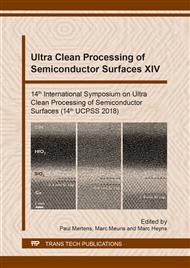[1]
T. Hattori, in Developments in Surface Contamination and Cleaning: Methods for Surface Cleaning, edited by Rajiv Kohli and K.L. Mittal, William Andrew. 9, 1-22, (2017) and references there-in.
Google Scholar
[2]
Vrancken, N.,Vereecke, G., Bal, S., Sergeant, S., Doumen, G., Holsteyns, F., Terryn, H., de Gendt, S., Xu, X.M. Solid State Phenomena; 255, 136-140, (2016).
DOI: 10.4028/www.scientific.net/ssp.255.136
Google Scholar
[3]
M. Sankarapandian, B. Peethala, D. Canaperi, D. Peter, P. Engesser, H. Okorn-Schmidt, The Risk of Pattern Collapse for Structures in Future Logic Devices,, Solid State Phenomena; 195, 107-109, 20, (2013).
DOI: 10.4028/www.scientific.net/ssp.195.107
Google Scholar
[4]
D. Eom, K. Kim, Y. Shina, Drying Performance of Single IPA Dryer to Prevent Pattern Collapse and Watermark., Meeting Abstracts, 41(30), 197–204, (2011).
DOI: 10.1149/1.3630844
Google Scholar
[5]
C.H. Kim, MS Yun, TH Hwang, CH Nam, SC Kim, JH Roh, MS Lee, JS An. Improved Drying Technology of Single Wafer Tool by Using Hot IPA/DIW., Solid State Phenomena, 195, 243–246, (2012).
DOI: 10.4028/www.scientific.net/ssp.195.243
Google Scholar
[6]
Vereecke G., Xu X.M., Tsai W.K., et al., Partial wetting of aqueous solutions on high aspect ratio nanopillars with hydrophilic surface finish,, ECS Journal of Solid State Science and Technology; 3(1), 3095–3100, (2014).
DOI: 10.1149/2.013401jss
Google Scholar
[7]
Y.Le Tiec, C Ventosa, N. Rochat, I. Radu. Water Management on Semiconductor Surfaces., Microelectronic Engineering, 88(12), 3432-3436, (2011).
DOI: 10.1016/j.mee.2010.10.017
Google Scholar
[8]
Y Le Tiec. Drying impact on semiconductor surfaces after innovative solvent exposure., Future Fab International. 35, 74-78, (2010).
Google Scholar
[9]
H.W. Chen, S. Verhaverbeke, R. Gouk, K. Leschkies, S. Sun, N. Bekiaris, and R. J. Visser. (Invited) Supercritical Drying: A Sustainable Solution to Pattern Collapse of High-Aspect-Ratio and Low-Mechanical-Strength Device Structures., 228th ECS Meeting, 69(8), 119–130 (2015).
DOI: 10.1149/06908.0119ecst
Google Scholar
[10]
J. Daley and Y. Hishiro, U.S. Patent No. 7119025B2 (2006).
Google Scholar
[11]
M.H. Somervell, B. Rathsack, I. Brown, S. Scheer, J. Hooge, U.S. Patent No. 9454081 (2016).
Google Scholar
[12]
R. Leung, D. Endisch, S. Xie, N. Hacker, Y. Deng, U.S. Patent No. US6653718B2 (2003).
Google Scholar
[13]
J.S. Drage, U.S. Patent No. 5858547 (1999).
Google Scholar


